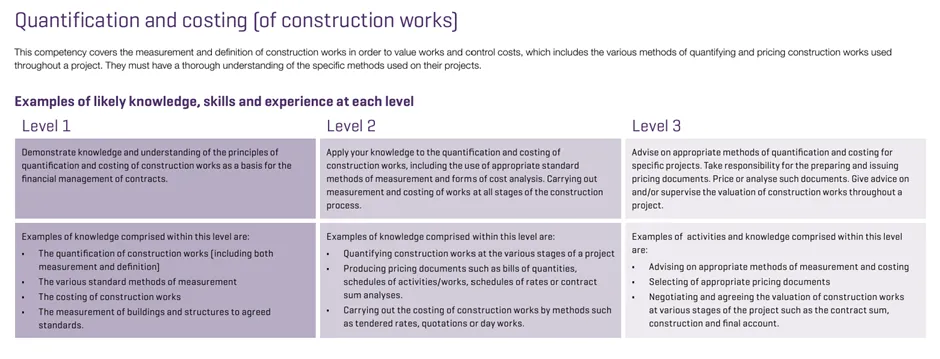
RICS APC: Quantification and Costing (of Construction Works)
As the mid-September 2024 submission window for RICS APC candidates sitting in 2024 Session Two is nearly upon us, we wanted to do a mini-series focused on technical competencies within the Quantity Surveying and Construction pathway guide.
We will do this by writing a five-minute article on each of the six core technical competencies which quantity surveyors form the pathway requirements. The intention is to give you some things to think about as you ready your experience record for submission. Whilst the article is RICS APC focused, the content will still be relevant to any construction professional looking to advance or refresh their knowledge in this area.
This week is our final article in this mini-series, and we close with quantification and costing (or construction work). This really is the competency for the quantity surveying purists with measurement right at the heart of it, and the competency where APC candidates should be looking to showcase their technical ability as a quantity surveyor.
The Definition
Quantification and costing (of construction works) ‘covers the measurement and definition of construction works in order to value works and control costs, which includes the various methods of quantifying and pricing construction works used throughout a project. They must have a thorough understanding of the specific methods used on their projects’.
A snapshot of the competency description from the pathway guide is provided at Figure 1, where you will see what is required of you at level 1, level 2 and level 3. At your APC assessment, you need to demonstrate that you have achieved level 3 competency.

Figure 1
Remember: level 3 is advising; level 2 is doing; and level 1 is knowing. What constitutes advice? The Oxford English Dictionary defines advice as ‘guidance or recommendations offered with regard to prudent future action’.
For me, in the context of the APC, this means there was an issue, and you used your professional judgement to understand the issue and recommend to your client or your employer as to the action which should be taken.
Let’s explore this further with some hypothetical examples of quantification and costing (of construction works)
Level 3, Bullet 1
At level 3, you are required to demonstrate that you can competently ‘advise on appropriate methods of measurement and costing’.
Your ability to give level 3 advice on methods of measurement will depend upon your level 1 knowledge and your level 2 application of that knowledge. I would recommend that APC candidates should have detailed knowledge of the two main methods of measurement (NRM2 and CESMM) at the very least. This will lead you to either reference advice you have given or, if you are asked hypothetically what you would advise in a given scenario, you can give an informed answer.
Your advice on costing will require you to demonstrate a range of costing methods from cost per unit headline rates through to first principles rates. You should be able to advise when the costing method is suitable and when it is not suitable and explain the associated risks and assumptions and how you would address these in any advice you give.
If you want to demonstrate commitment to your craft as an APC candidate, then this is where you need to shine by showing your technical expertise.
Level 3, Bullet 2
At level 3, you are required to demonstrate that you can competently ‘select appropriate pricing documents’.
The selection of appropriate pricing documents links to the procurement and tendering competency because your selection will depend upon the risk allocation.
If you do not have a design which can be measured to the required standard, or issued to the supply chain for pricing, you might advise that an approximate quantities approach is suitable. You can evaluate tenders fairly and place an order in advance of design becoming available, thereby maintaining the construction programme.
In your selection and advice, you need to show and demonstrate your understanding about how the selection of a pricing document can help, or hinder, the administration of the contract or sub-contract. This is because the pricing schedule will be used to value interim payment notices and value variations.
You should talk about how you link these issues together to advise the selection of pricing documents that are both appropriate and lead to robust valuations during the contract administration phase.
Level 3, Bullet 3
At level 3, you are required to demonstrate that you can competently ‘negotiate and agree the valuation of construction works at various stages of the project such as the contract sum, construction and final account’.
There is a link between bullets 2 and 3 – your selection of an appropriate pricing document underpins your ability to value at various stages of the project of which there are, principally, two key stages (interim valuation and final valuation).
In both cases, interim and final, your valuation of a subcontract account is advice to your business as to the correct valuation up to a certain date. You make this recommendation and support it with calculations of the amount due and supporting documents. You may not think it, but this is advice as your seniors will either query your recommendation or approve it for pa
Final Reflections
This is a very “QSy” competency, and you should be looking to demonstrate (maybe even show off) a high level of technical knowledge and ability. This competency is less about how you use your ability to influence your stakeholders with reason and more about how you influence with the depth and quality of your quantity surveying expertise.
As an assessor, I really enjoy candidates who exude a passion for their profession. There is so much material available online so make sure you find it, read it, absorb it. Demonstrate that you know your craft and you understand how to quantify. It will be well received by your assessment panel.
In next week’s article, we start a new mini-series focused on design and issues within that very wide subject which might be helpful for quantity surveyors.
Keep an eye out for that and, in the meantime, enjoy the rest of your week!
Bringing The science of Quantik® to you
p.s. If anything in this article, or any of our articles, resonates with a challenge you are experiencing, check out our ‘Bringing The science of Quantik® to you’ initiative where we offer a tailor-made session aimed at helping you tackle your project or business challenge (link below).
Form: https://form.jotform.com/241425931072350

THE SCIENCE OF QUANTIK™
Publications
We publish insights through our LinkedIn newsletter, titled “The science of Quantik”, which are light bites of information covering news and insights relating to the construction industry and quantity surveying.
LinkedIn